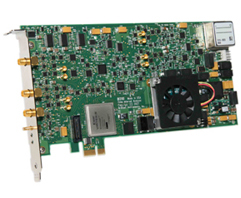

PCIe总线时间间隔分析仪卡

TIAs are the most powerful type of time measurement instruments. In addition to the functions provided by traditional “frequency counters”, “time interval counters” and “universal counters”, TIAs include new functions, run at a much higher rate, provide a continuous measurement capability, and report results together with their time of occurrence. These capabilities give you much more insight into the dynamic nature of your signal and much higher throughput.
This difference in capability is similar to the difference between voltmeters and oscilloscopes. Although both voltmeters and scopes measure the voltage of a signal, the scope provides much faster sampling and displays the results vs. time. For example, the voltmeter may be able to make 1000 measurements per second, which you can log with a computer. You may also log the time of occurrence of each measurement and display a plot of
voltage vs. time. This plot looks a lot like an oscilloscope display but it only works for signals with very slow voltage variations. The scope on the other hand can sample the voltage at gigahertz rates and displays a plot of these samples vs. time. It therefore provides much more insight into the variations in the signal.
The BI200 TIA can make 4 million measurements per second. Each of these measurements can be an instantaneous frequency measurement, a time interval measurement, or any of one of 10 measurement functions. For time measurements, each of the measurements would have a resolution of 3 ps. For frequency measurements, each measurement would provide 5 digits of resolution. As the measurement rate is decreased, the frequency resolution is improved.
型号:
| 型号 | 最大频率. (All Func.) | Max Freq. (Freq. Func.) | Time Resolution | Freq. Resolution | Meas. Rate | 最小脉冲宽度 | 接口总线 | 详细说明 |
|---|---|---|---|---|---|---|---|---|
| BI200 | 2 GHz | 2 GHz | 3 ps | 12 Digits/s | 4 MSa/s | 100 ps | PCIe | |
| BI201 | 800 MHz | 800 MHz | 3 ps | 12 Digits/s | 4 MSa/s | 100 ps | PCIe | |
| BI220 | 400 MHz | 2.5 GHz | 8 ps | 12 Digits/s | 1 MSa/s | 1 ns | PCI | |
| BI221 | 400 MHz | 5.0 GHz | 8 ps | 12 Digits/s | 1 MSa/s | 1 ns | PXI | |
Max Freq. (All Func.) - This is the maximum frequency for all measurement functions without prescaling (frequency division)
Max Freq. (Freq. Func.) - This is the maximum frequency for the frequency-type functions (1C1E) when using the prescaler for products with a prescaler (frequency division). See the datasheet for details.
Time Resolution - The single-shot time resolution of the hardware.
Freq. Resolution - The resolution for Frequency Average and Period Average functions is dependent on the single-shot time resolution and the duration of the measurement (effective gate time). It is easier to specify it as a number of digits per second. For example, 12 digits/s means that you will get 12 digits of frequency resolution with a 1 second gate time, or 9 digits in 1 millisecond. If the signal input is 1 MHz, 9 digits of resolution translates to 0.001 Hz resolution.
Meas. Rate - The maximum number of measurements per second that the instrument can take. This is due to the recovery time of the measurement circuits. Time interval analyzers (as opposed to traditional counters) still count the pulses (events) of the input signals during this recovery time, but no timetags are produced. For example, if the input frequency is 100 MHz and the instrument has a measurement rate of 4 MSa/s then a measurement can be made as often as every 25 cycles of the input.
Min. Pulse Width - The minimum pulse width for the input signal.
Interface - The computer bus interface
010-62156134 62169728 13301007825 节假日:13901042484 微信号:sun62169728
地址:北京市西城阜外百万庄扣钟北里7号公寓
E_mail:sales@pc17.com.cn 传真: 010-68328400
京ICP备17023194号-1 公备110108007750




 售价:¥0
售价:¥0